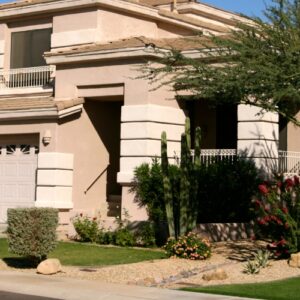
If you’ve never used landscape lighting, you may be surprised at what a difference it can make. When daytime temperatures in the northern Phoenix area drive us indoors during the summer, the cooler nighttime hours become the best time to enjoy your yard and garden. And the right types of landscape lighting make all the difference.
Where to Add Lighting to Your Yard
A softly lighted pathway can lead the way to a pergola, a string of lights under your awning can make dining al fresco seem like a vacation, or highlighting a tree or favorite shrub with a soft glow can give an entirely different look at night. If you have steps or a dark walkway, lighting can also serve as a safety feature.
And it’s not just hardwired lighting that enhances your outdoor spaces. Solar lights are a great option to line sidewalks, and there are also solar-powered string lights, spotlights and lanterns. After all, we get plenty of Arizona sunlight to power solar lights!
Choosing the Right Light “Color”

Comparison of color temperature of 5 CFLs and one incandescent lamp. From left to right: 100 watt soft white incandescent, 2700K CFL, 3500K CFL, 4100K CFL, 5500K CFL, 6500K CFL. All CFLs are 100 watt replacements, ranging from 23 to 26 watts. Via Wikimedia.org
Most landscape lighting looks white to the human eye, but some is “warmer” and some is “cooler”. Lamps (light bulbs) are classified by color temperature, ranging from blue/cool (5000K or higher) to orange/warm (2700-3000K).

The light may look white, but the color temperature of most LED lights is blue
Blue/Cool Light (5000K+) – The sun produces blue light (this is why the sky appears blue). Our body reads it as a signal that it’s time to be awake. Blue light during daylight hours boosts attention, mood, and reaction times, but at night it keeps us awake. Artificial blue light comes from our phone screens, computers, televisions, tablets, and most florescent and LED lights (including street lights).
Orange/Warm Light (2700-3000K) – On the opposite side of the color spectrum is warm light. Sources of warm light include a campfire, a candle, or most older (non-LED) style light bulbs.
Remember that these lights will all look white to our eyes, so it’s important to pay attention to the temperature rating on the packaging of the lights that you purchase.
Avoid Blue Light in Your Landscape
If you’ve ever been to Las Vegas, you know what light pollution looks like (and all the neon!). We now know that too much light can be a bad thing. Here are just a few ways that bright lights at night can negatively affect the world:
Migrating birds die of exhaustion – Certain types of birds travel at night to avoid predators and are guided by the light of the moon. Bright lights in and near cities confuse the birds and they lose their way. Some birds crash into reflective buildings and are killed – others circle for hours, trying to find their way, until they eventually collapse from exhaustion.
Stars disappear – The Arizona desert is beautiful during the day, but absolutely jaw-dropping at night, especially if you’re used to the 80% of the US where most stars (and the Milky Way) are not visible. The light pollution from Phoenix is growing, however, and every year fewer stars are visible. We just don’t want to end up like Los Angeles – in 1994 there was a power outage caused by an earthquake, and the Milky Way was visible. Most people didn’t know what they were looking at, and stories abound about 911 calls from confused stargazers.

Light pollution in the Anthem area from https://www.lightpollutionmap.info/
We lose sleep – The blue light from electronics (and LED lamps, including streetlamps) is messing with our sleep schedules. Blue light is great during the day because it increases energy and focus, but it also suppresses melatonin, a natural hormone that helps us sleep.
It harms our health – Blue light scatters more than warmer light, so it can cause electronic eye strain, especially if you’re staring at a computer, television, or phone screen for multiple hours. Studies have linked artificial blue light to greater risks of certain cancers, diabetes, heart disease, obesity, and depression.
Plants rely on signals from the sun – Plants survive by making food through a process called photosynthesis, and sunlight is vital for that process. But plants and trees also need a time of rest. Studies show that trees next to streetlights (the kind that stay on all night) lose their leaves later in the fall. That’s because the trees rely on signals from nature to know what time of year it is. Since the lights signal that the days aren’t getting shorter, trees continue growing as if it’s still summer. That can be harmful over time.
Creosote is a good local example. It’s so well adapted to our summer heat that it knows to only photosynthesize during the early morning hours. If a light is shining on it all night, it may not be sure when to open its leaves and when to keep them closed!
So, knowing all those things, how can you choose the right landscape lighting for your yard?
Landscape Lighting for Northern Phoenix
Not all light is bad, but hopefully you now better understand why light should be limited – especially during the nighttime. The good news is that most of us don’t hang out in our yards during the wee small hours, so using landscape lighting for a few hours in the evening, especially if you choose a warmer light, should be fine.
When choosing landscape lighting:
- Make sure you’re following the law. In Arizona, any light brighter than 150 watts is required to be shielded. Maricopa County prohibits any type of Mercury vapor fixtures (a type of blue light), and requires that all outdoor lighting be fully or partially shielded, depending on the type of light. There are also regulations about hours that lights have to be shut off.
- Don’t leave lights on all night. Put your lights on a timer and/or turn them off when they’re not needed. This will also lower your electricity bill.
- Ensure your lights face down. You waste money if most of your light goes up into the sky and contribute to the growing light pollution problem.
- Buy dark sky friendly fixtures. In some Arizona cities this is already a requirement, so you might as well buy them now.
- Try to restrict any kind of blue light exposure after sunset. For electronics, switch to night mode or buy blue-blocking glasses. For outdoor lights, use bulbs that are 3000K color temperature or lower (some recommend 2750K or lower)
- Make sure your lights are the correct brightness for their purpose. Many outdoor fixtures cause glare and are too bright for you to actually enjoy your time outdoors.
- Be a good neighbor and position your lighting correctly. Avoid “light trespass,” where your light seeps on to other properties. If this happens, your neighbor has the legal right to complain (this happens more than you might think!)
Other things that you can do:
- Join the Lights out Program, part of the Audubon Society.
- Talk to your city or HOA about using fewer blue lights in public places.
- Share this article to raise awareness of this issue. Because so many people can’t see the stars, most don’t know what the night sky actually looks like or that it is endangered.
- Learn much more about light pollution at the International Dark Sky Association website.
See Our Latest Articles
More Articles Like This

Titan Tree Care is a full-service tree care company located in Anthem, AZ and serving all of North Phoenix. We offer a wide range of services to meet your tree care needs, including tree and palm trimming, tree pruning, tree removal, stump grinding, and more. We also offer insect or disease treatments and fertilization services. We are dedicated to providing high-quality, safe, and effective tree care services to our customers and work hard to ensure that your trees are healthy and look their best.









